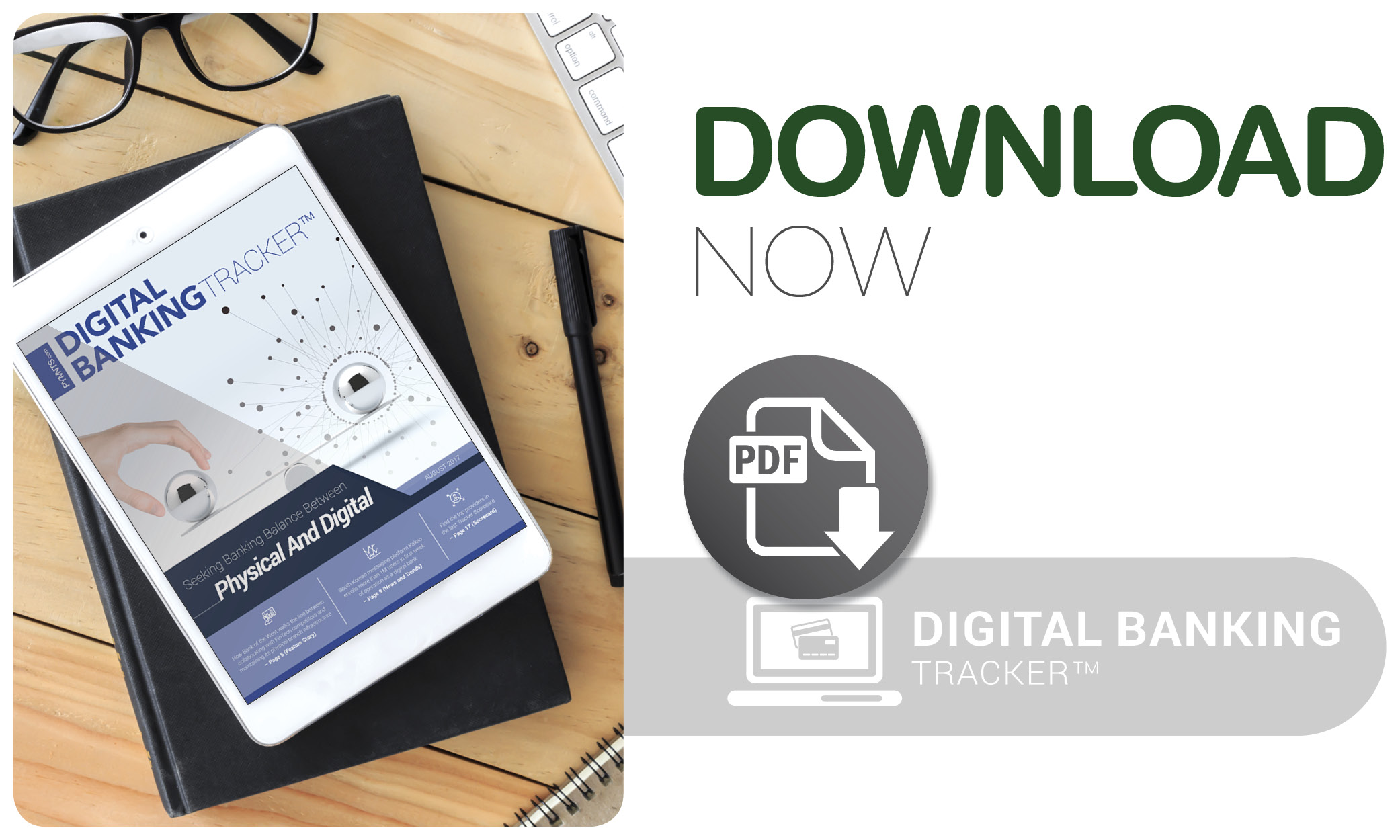Seeking Banking Balance Between Physical And Digital

Recent studies find most bank customers — yes, millennials too — still prefer having a physical branch nearby. So, how can banks balance operational costs with innovation? For the latest Digital Banking Tracker™, PYMNTS speaks with Jamie Armistead, EVP of Digital Solutions for Bank of the West, about how the bank works alongside FinTechs to innovate digital and physical capabilities. Plus, digital banking news from around the space and a provider directory with over 200 providers, including nine new additions, inside the Tracker.
With more consumers moving to mobile transactions over visits to branches, some banks are considering closing brick-and-mortar locations to reduce operational costs.
The price of real estate is prompting even the largest players in the banking world to scale back their branch operations. Chase, Wells Fargo, Bank of America and Citi, to name a few, all scaled back their physical bank branch locations between 2012 and 2016, according to the Federal Deposit Insurance Corporation (FDIC).
Additionally, if recent trends are any indication, physical bank branches stand to lose a lot of ground in the near future. According to a recent CNBC interview with Anthony Jenkins, former CEO of Barclays, bank branches will be as “common as a Blockbuster video store in a few years’ time.”
But, while closing physical bank branches might appear to be a wise cost-saving measure, the move comes with risks that could hurt banks’ relations with new millennial customers. Despite the commonly held misconception that tech-savvy millennials are only interested in digital banking, millennials have said they actually want a physical bank to be available to them.
A recent report from SurveyMonkey, a cloud-based survey development company, found that 80 percent of millennials said they want the option to visit a bank branch in person. Results also noted this generation is less likely to open a bank account if physical bank locations are not available in their communities.
Branch closures can prompt some customers to ditch their banks once they lose access to a nearby physical branch. A separate survey from management consulting firm Bain & Co. found banks that close their physical branches risk losing existing customers to rival banks. According to Bain’s research, 40 percent of customers whose main bank branch shuttered in the previous 12 months reportedly switched banks or used a new financial institution to buy new banking products.
The problem persists: Maintaining physical infrastructure can be costly, but downsizing locations can risk alienating the customer base. Can banks have it both ways?
For American regional financial services company Bank of the West, a division of international bank BNP Paribas, striking the right balance has meant seeking collaborations with competitors in the FinTech space instead of focusing on a digital-only approach. Jamie Armistead, executive vice president of Digital Channels for Bank of the West, recently spoke with PYMNTS about how startups and tech are informing his company’s innovation strategy. Armistead also spoke to the lesson the bank is learning from smartphone apps to better serve its customers online and in brick-and-mortar locations.
Staying on Top of Customer Expectations
With mobile banking technology on the rise, it has seemingly become more important than ever for banks to stay on top of the latest digital innovations. For traditional banks, the largest impact of mobile and digital technology has been how it has shifted consumer expectations.
“As more and more people move toward use of digital channels for their banking services, their expectations of what they can do in those channels has grown tremendously,” Armistead said.
For Bank of the West, this has meant trying to get in front of expectations rather than perpetually attempting to catch up. It has also meant working in anticipation of the changing needs of millennial users. Last year, for instance, the San Francisco, California-based bank formed a partnership with Silicon Valley startup accelerator Plug and Play, giving the bank access to an innovative tech ecosystem allowing it to harvest new solutions.
With the partnership in place, Armistead said, Bank of the West is tapping into the expertise and capabilities of nearly two dozen FinTech companies on the Plug and Play platform and is working on several commercial pilots.
“We can tap into some of those early stage companies, what they’re thinking, what they’re identifying as interesting solutions,” he said. “It’s a really exciting time to be in the space.”
Among the participating FinTechs are Payso, SnapCheck and Token. In addition to Bank of the West, other banking partners working with the Plug and Play platform include Capital One, Deloitte, Santander Bank, TD Bank and USAA, among others.
Getting in Front of Change
While partnering with FinTech companies to develop meaningful products is one way to keep customers engaged, offering those products in a cost-effective way has now become even more important. According to Armistead, this stands especially true when the competition is between larger players in the financial services industry — many of which have deeper pockets — and when the target customer base includes millennial customers with a different approach to fees.
Addressing millennials’ frustrations with bank fees helps banks find solutions that can serve the broader customer base. The pain point offers an opening for smaller players to step in, and those smaller players can entice millennial customers with products that make it easier for them to avoid these costs.
Armistead pointed to Bank of the West’s new Any Deposit Checking feature, released earlier this year in direct response to millennial influence. The account automatically waives a $10 monthly service fee if the account holder is younger than age 25, a move to appeal to new, younger bank customers.
Offering services that help customers sidestep bank fees is one way to address the needs of younger customers. According to Armistead, these types of products can also help the bank address the demands of non-millennial customers, as the fee can be waived if a customer makes any type of deposit — including ATM, direct deposit or by visiting a bank branch in person.
“It’s not as though the things we do for millennials do not accrue benefits for our broader customer base,” he said. “You just start with that digital-first mindset.”
Inspiration in Mobile Apps
For Bank of the West, taking a digital-first approach has meant taking cues from non-banking platforms such as traffic navigation app Waze, rideshare apps like Uber and social media platforms like Instagram and Snapchat — all of which have set a benchmark for successfully connecting with users across the entire spectrum.
“It sets the bar relative to the experience expectations that people have,” said Armistead. “I don’t think we should be given a pass because we’re a bank.”
Uber, for one, has been particularly inspiring for Bank of the West. Its success in taking the payment pain points out of daily commuting is something that also needs to define product development in consumer banking, according to Armistead. This is particularly true when banks step out of their traditional roles to meet consumers when and where they want.
Providing that experience to Bank of the West customers has meant extending a similarly frictionless mobile experience to its customers, including features like quick balance review, which, incidentally, was the first of its kind in North America.
“We looked at [this]: What is the most basic of banking transactions? Checking your balance,” Armistead said. “We created the capability to check that balance without logging in to the mobile app. Just launch the app with a simple gesture, and we bring up your balances.”
Reinventing Bank Branches
While the bank maintains a digital-first approach, Bank of the West has no intention of abandoning its brick-and-mortar branches and shifting to a mobile-only or digital-only operation, Armistead said.
After all, despite the recent advancements in digital banking, tech-savvy customers still appreciate the knowledge that a physical bank branch is nearby for in-person interactions, he said. The reports from SurveyMonkey and Bain & Co. appear to support that claim.
“When we look at our customers, we see that a majority of accounts are still opened in branches,” Armistead said.
So, instead of moving away from physical branch locations, the bank is continuing to work on enhancing the branch locations’ digital capabilities and on staffing each branch with digital specialists that receive additional training in newer technologies. These digital specialists will help bank branches introduce new capabilities to their customers.
All told, Armistead believes Bank of the West’s physical bank branches and digital solutions will work together as partners, not competitors.
“We see a harmony between digital capabilities and the branches,” he said.
In other words, while digital banking tools are gaining popularity, it may not be time to start shuttering physical bank branches just yet.
. . . . . . . . . . . . . . . .
TO DOWNLOAD THE AUGUST EDITION OF THE PYMNTS DIGITAL BANKING TRACKER™, CLICK THE BUTTON BELOW.
About the Tracker
The PYMNTS Digital Banking Tracker™ brings you the latest news, research and expert commentary from the FinTech and consumer banking space, along with the rankings of over 200 companies serving or powering the digital banking sector.

